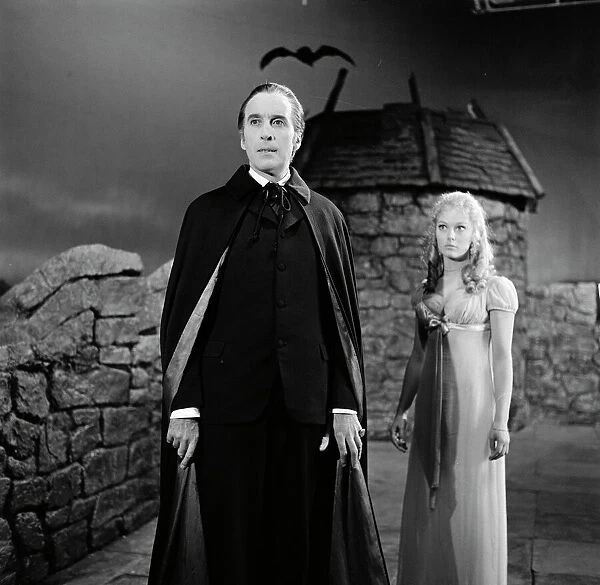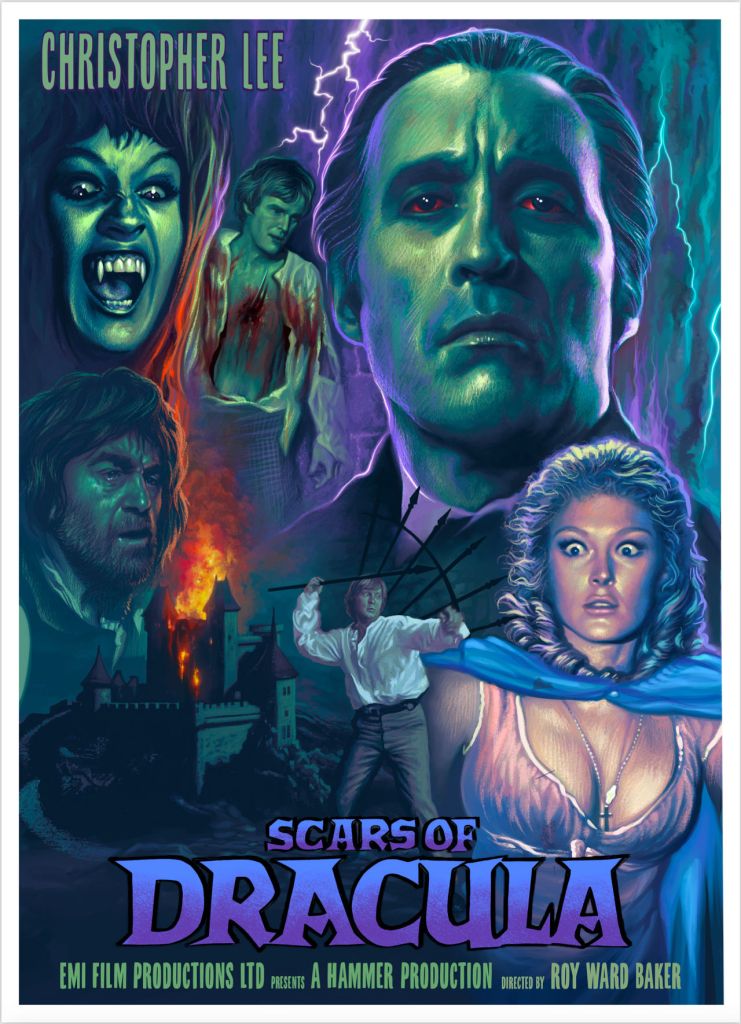SCARS OF DRACULA: Not Much Power in the Blood

Christopher Lee returned to the role of the iconic horror villain Count Dracula for the fifth time in the employ of Hammer Studios (he had also played the count for Jess Franco in a 1970 feature, but that was a non-Hammer production) in 1970’s Scars of Dracula. Behind the camera on director duty this time around was the great Roy Ward Baker (Quatermass and the Pit), who had previously dabbled in bloodsucker cinema with the erotically-charged The Vampire Lovers starring Jon Finch, the luscious Ingrid Pitt, and Lee’s fellow Hammer star and occasional screen nemesis, Peter Cushing.
As always, even though he was stone cold dead at the end of his last movie (as he is in every one of them), Dracula is brought back to life in Scars’ opening moments. This time, the source of the count’s latest revival is a Halloween store rubber bat that spews blood on his remains, which then grow back into Lee’s familiar form (I’m getting major Hellraiser vibes here). He resumes his killing spree once more and the villagers, sick and tired of finding Dracula’s discarded dead female victims, stage a torch-wielding raid on his matte painting castle (they’re British enough to ring the doorbell first).
Despite the protestations of the count’s beastly henchman Klove (the second Doctor himself, Patrick Troughton), the villagers succeed in setting fire to the castle. Unfortunately, this doesn’t kill Dracula, but it does royally piss him off, and the vampire retaliates by slaughtering a church full of women and children (the camera loves lingering on the gruesome aftermath) while the men of the village are still jubilant from their victory against evil. Go figure.

The fun doesn’t stop there though. In need of a quick escape after being falsely accused of rape, local screw-up Paul Carlson (Christopher Williams) finds himself a guest at Castle Dracula, and that doesn’t go too well. His brother Simon (Dennis Waterman) and Simon’s fiancée Sarah (Jenny Hanley) arrive at the castle in search of Paul. From there, it’s pretty much bloody business as usual. I’m talking lusty maidens, enveloping fog, out-of-control stagecoach chases, pubs full of superstitious British bumpkins, proper ladies and gentlemen battling the forces of evil, and lots of blood in the brightest shades of red. Everything you’d expect from a Hammer Studios Dracula feature, and then some.
By the time Scars went into pre-production, Lee had reportedly had his fill of Dracula and wished to move on. As the rumor goes, Hammer toyed with making Scars a soft reboot of the series with another actor stepping into Lee’s cape (supposedly John Forbes-Richardson, who would go on to play the count in 1974’s Baker-directed The Legend of the 7 Golden Vampires, which also brought back Cushing for another go-around as Van Helsing). That would explain the lack of continuity between Scars and the series’ previous entry, the same year’s Taste the Blood of Dracula, and the injection of elements from the original Bram Stoker novel in the film’s characterization of Dracula.

The most famous vampire in the history of…well, everything, gets a little more to do and say in Scars, but even with another game performance from Lee (though some of his trademark ferocity in the role would have been nice to see) and Baker’s typically engaged direction, the final product doesn’t exactly take chances with respect to the well-established formula of Hammer’s Dracula franchise. A few narrative shake-ups might have helped to craft Scars into one of the best British horror films ever made, but instead its slavish adherence to pleasing the audience results in a disappointingly by-the-numbers flick that throws plenty of the old favorites at us without something original or challenging in the screenplay by Anthony Hinds to justify its existence as anything more than an assembly line piece of work.
Pacing drags a bit during a rather uneventful second act, a real letdown after an opening reel overflowing with action and energy. The lead performances from Waterman and Hanley are perfectly adequate despite the actors being saddled with uninteresting characters. Outside of Lee, the best player in the cast is Troughton, giving his all as a seemingly loyal follower of Dracula who turns out to be more sympathetic than you might first suspect.

Cinematography by Moray Grant (who also shot The Vampire Lovers for Baker) is solid and rich with saturated colors and foreboding atmosphere. Scars was the last of the Christopher Lee Dracula features to be scored by James Bernard, the great in-house composer at Hammer who also provided the brooding and booming soundtracks for the likes of The Curse of Frankenstein, The Quatermass Xperiment, and The Gorgon. Bernard would later collaborate with director Baker on 7 Golden Vampires, but his score for Scars of Dracula is a solid accomplishment of lush and terrifying melodies that go further in the service of generating tension for the generic plot than the film’s own script.
If anything, the most reassuring aspect of Scars of Dracula is the film’s confirmation that Christopher Lee, may he rest in peace, would own the iconic role for the time being until a worthy successor came along. Luckily for fans of the series who were started to grow tired of the overreliance on formulaic, the likes of The Satanic Rites of Dracula and Dracula A.D. 1972 would soon be along to shake some of the cobwebs out of the franchise and liven up the stale proceedings as best as their budgets and meager expectations would allow.

Leave a comment